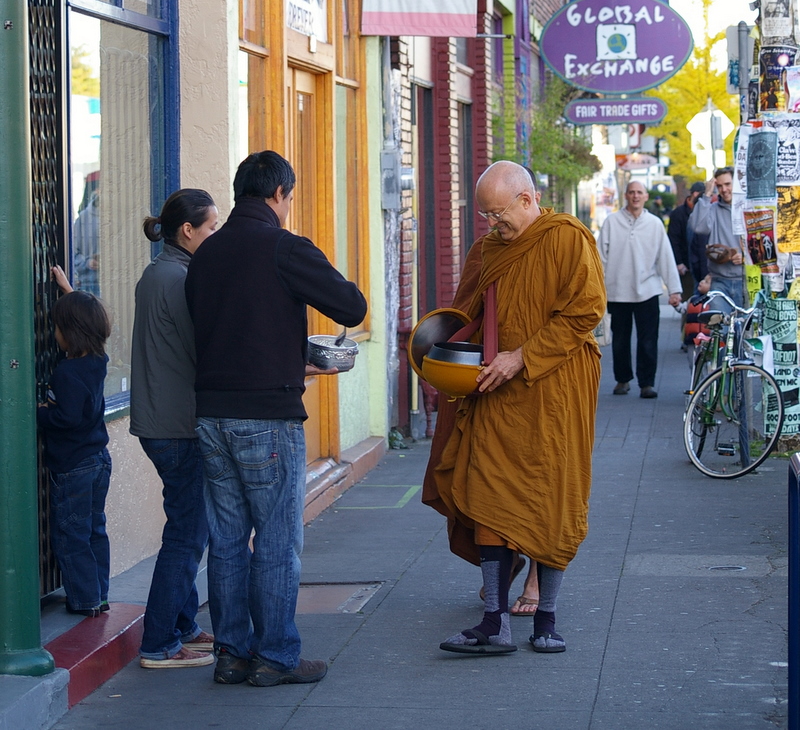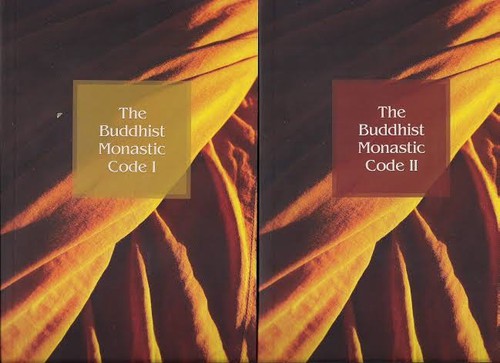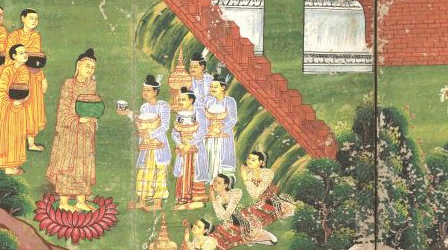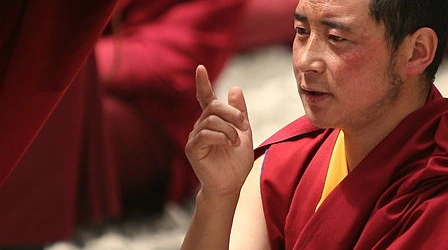Vinaya Studies
Subscribe to this topic via: RSS
The practical study of the monastic code, primarily by and for monastics seeking to hone their discipline.

Ajahn Geoff uncovers his alms bowl to receive rice from a family in downtown Portland one brisk October morning in 2008. (Mary Reinard, BY-SA 3.0)
Table of Contents
Books (7)
Featured:
-
In the 1970s, Ajahn Brahm began writing his own translation of and commentary on the Vinaya in order to support his fellow, Western monks who, at the time, lacked such a resource in English.
-
A simple comparison of the Theravāda and Mahāyāna Pātimokkhas.
See also:
Canonical Works (24)
Featured:
-
The present compilation brings together in English translation the most important Pali Vinaya texts dealing with the first rule in the Sanghādisesa section of the Bhikkhu Pātimokkha: the training rule on intentional emission of semen — one of the disciplinary rules most fundamental to [a bhikkhu’s] training.
-
A dispute about livelihood or about the Pātimokkha would be trifling, Ānanda. But should a dispute arise in the Sangha about the path or the way, such a dispute would be for the harm and unhappiness of many
-
⭐ Recommended
Then the Venerable Mahamoggllana took that person by the arm, pulled him outside the gate, and bolted it.
-
I say that this person is like the warrior who is killed and finished off by his foes. Some people are like that.
-
⭐ Recommended
… over a hundred and fifty training rules come up for recitation, in which gentlemen who love themselves train.
-
Bhikkhus, there are these three authorities. What three? Oneself as one’s authority, the world as one’s authority, and the Dhamma as one’s authority.
-
Even the enlightened can break the minor rules. Yet, training in the rules is still important.
-
Monks, these five future dangers, unarisen at present, will arise in the future. Be alert to them and, being alert, work to get rid of them.
-
One such as that is
like a sewer
brimful with years of filth
for it’s hard to clean one full of grime. -
Someone who formerly lived alone
and then resorts to sex
is like a chariot careening off-track; -
Monk, can you train in reference to the three trainings: the training in heightened virtue, the training in heightened mind, the training in heightened discernment?
-
With eight qualities a monk may be appointed to teach the nuns.
-
… the Saṅgha may, if it wishes, turn the bowl upside down for a lay follower on eight grounds.
-
The Buddha tells a short fable about a turtle to warn the monks about infatuation with fame.
1 page -
And how, bhikkhus, does a bhikkhu, based upon virtue, established upon virtue, develop and cultivate the Noble Eightfold Path?
See also:
Readings (30)
Featured:
-
⭐ Recommended
Vinaya narration like the Sudinna tale does not function in a way comparable to a record of case law precedents in modern judicial proceedings. Instead, the stories need to be understood in terms of their teaching function
-
🥇 Best of
This paper introduces a new distinction between the ‘formal’ and the ‘practical’ canon[…] in medieval Sri Lanka. I show that few monks encountered the [Vinaya] in anything close to its full form.
[Rather,] Monastic leaders considered the Anumāna, Dasadhamma and (Karaniya)metta Suttas to be [the important sources] for monastic education. -
The Mūlasarvāstivāda Vinaya’s vibhaṅga to pārājika three reports that the Buddha refused to establish a rule in a number of “borderline” cases—including for an abortion.
101 pages -
… the relevant Pāli data about [ten technical] terms occurring in the Vinaya, [its commentaries] and in secondary literature
-
🥇 Best of
The Vinaya has outlasted Hammurabi and Justinian because it is a set of spiritual exercises rather than a legal system.
-
🥇 Best of
… a detailed analysis of the guidelines on sleeping practices as stipulated in Buddhist monastic disciplinary texts and in Chinese manuals.
-
The Anguttara-nikāya does not recognize a form of atonement for pārājika, just as the śikṣādattaka observance does not imply a re-evaluation of the nature of a pārājika offence. Instead, the latter only involves an institutionalization of an option already available earlier, namely to continue to live at a monastery in robes but without all the privileges that come with full ordination.
-
An overview of some of the Vinaya rules regarding communally owned property according to the Theravāda Tradition.
-
If the frustrated zombie turns back on the instigator and kills him, the monk incurs a heavy fault. I do not know whether there are any other cases of posthumous penalties in the monastic codes, but here we have at least one.
-
A comparison of the Pācittiya rules of the six schools for monks exhorting nuns showing that there is widespread agreement on Pā 21, 22, and 24 but significant disagreement between the Vinayas regarding Pā 23.
-
… the saṃgha is a collective body of people who wish to live doing only what they love to do—that is, Buddhist practices.
-
⭐ Recommended
Paying money to this teacher I came to an understanding of the values of “This World.”
-
A spiritual community is nothing if it cannot take care of its most vulnerable.
-
⭐ Recommended
A short essay on what the path is to become a Theravāda Monastic.
-
… the owners of the monastery are the worldwide and “timewide” community of monks and nuns
-
Sangha decisions are always made locally. The Vinaya doesn’t countenance centralized, monastic authority.
See also:
Audio/Video (5)
Featured:
-
⭐ Recommended
Textual fundamentalism requires texts.
See also:
Reference Shelf (3)
Featured:
-
⭐ Recommended
Less conservatively preserved than the monks’ rules, the Bhikkhunī Pātimokkha must be studied comparatively to get a sense for what their original rules might have been: a scholarly process which continues to this day.
See also:


